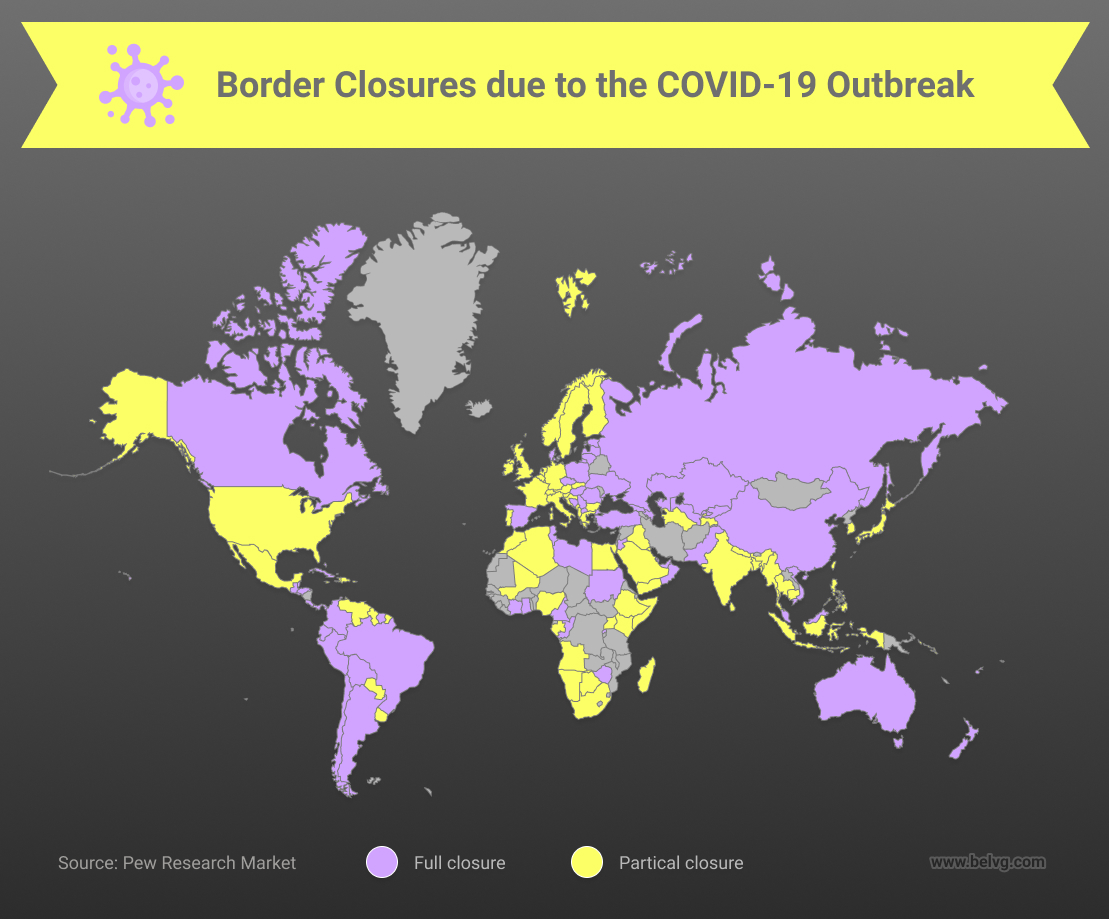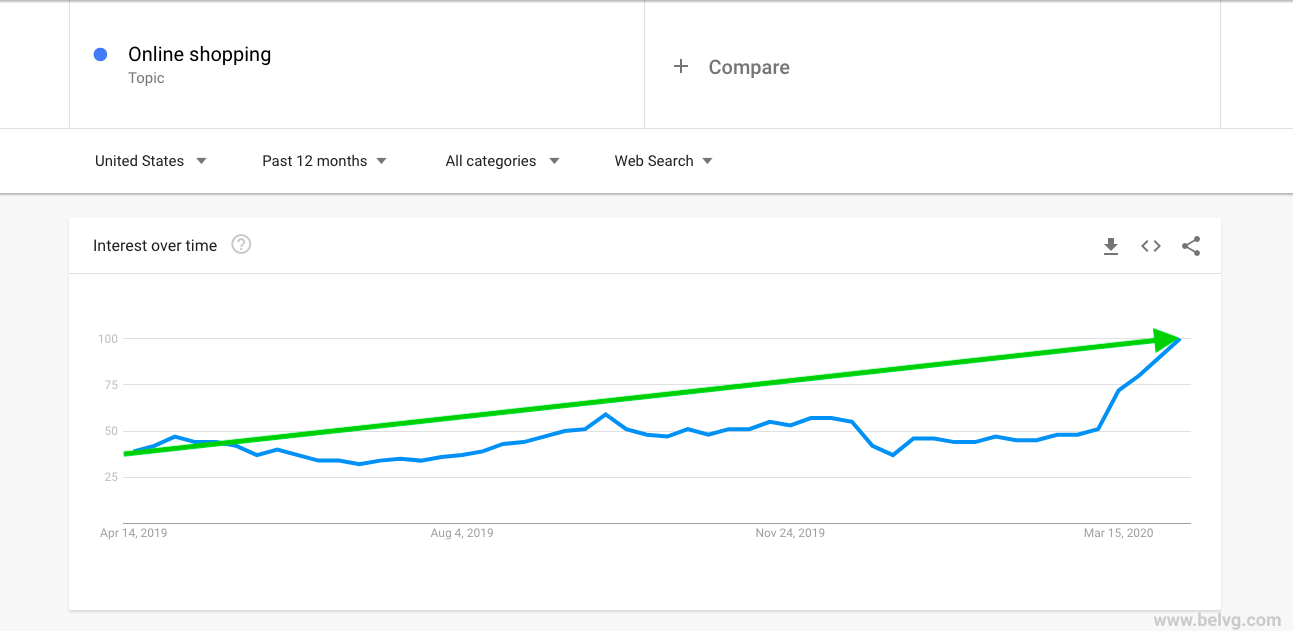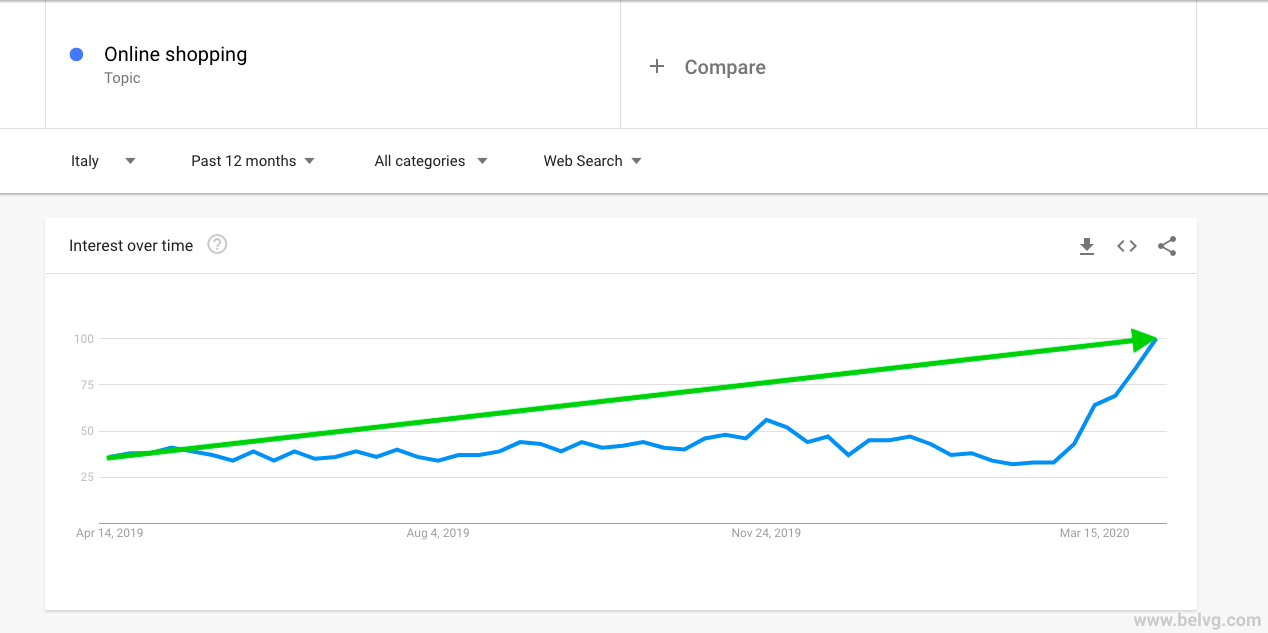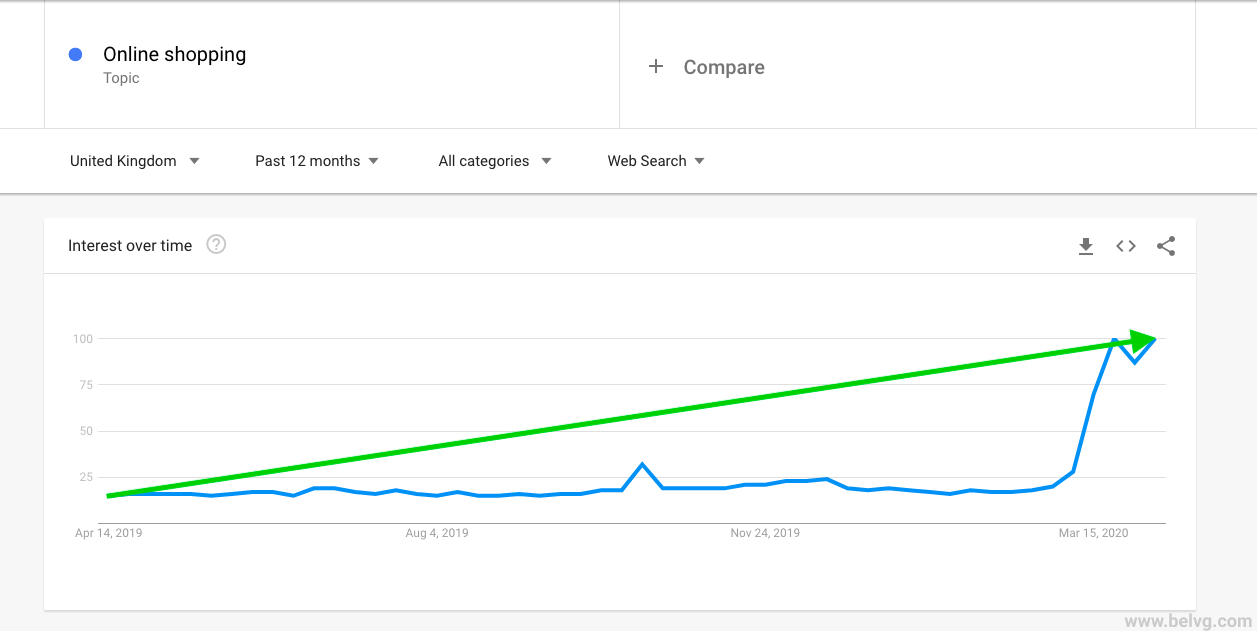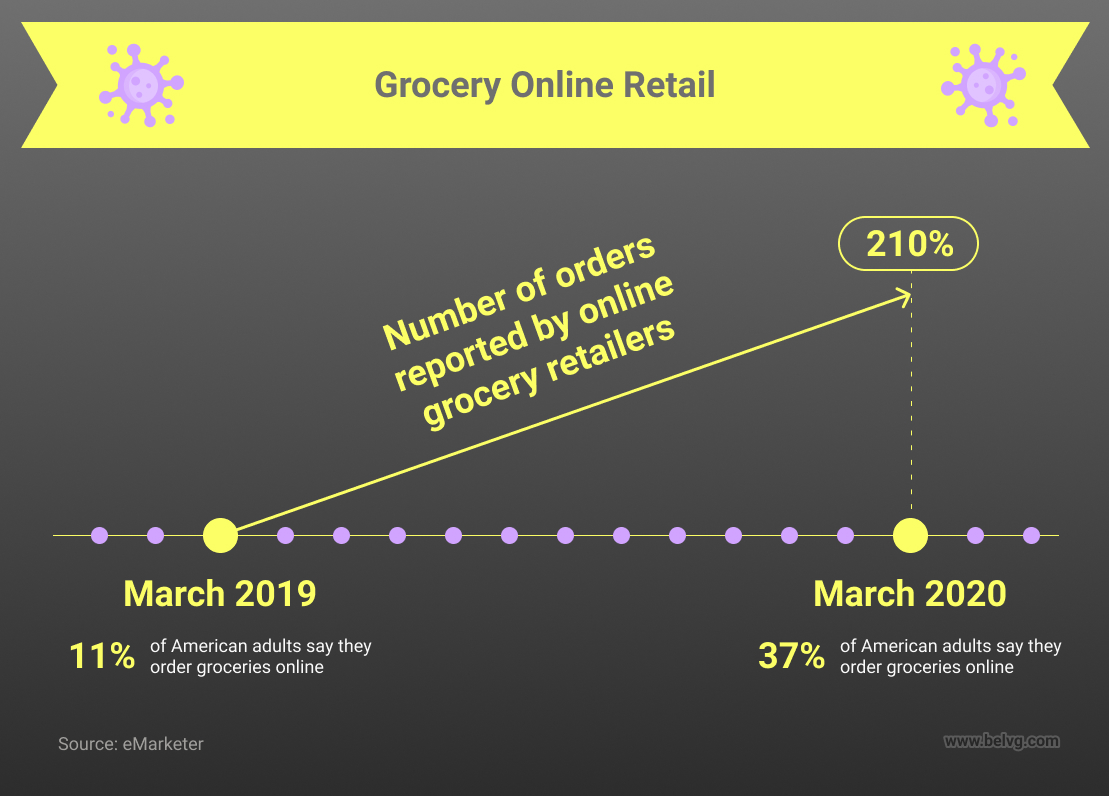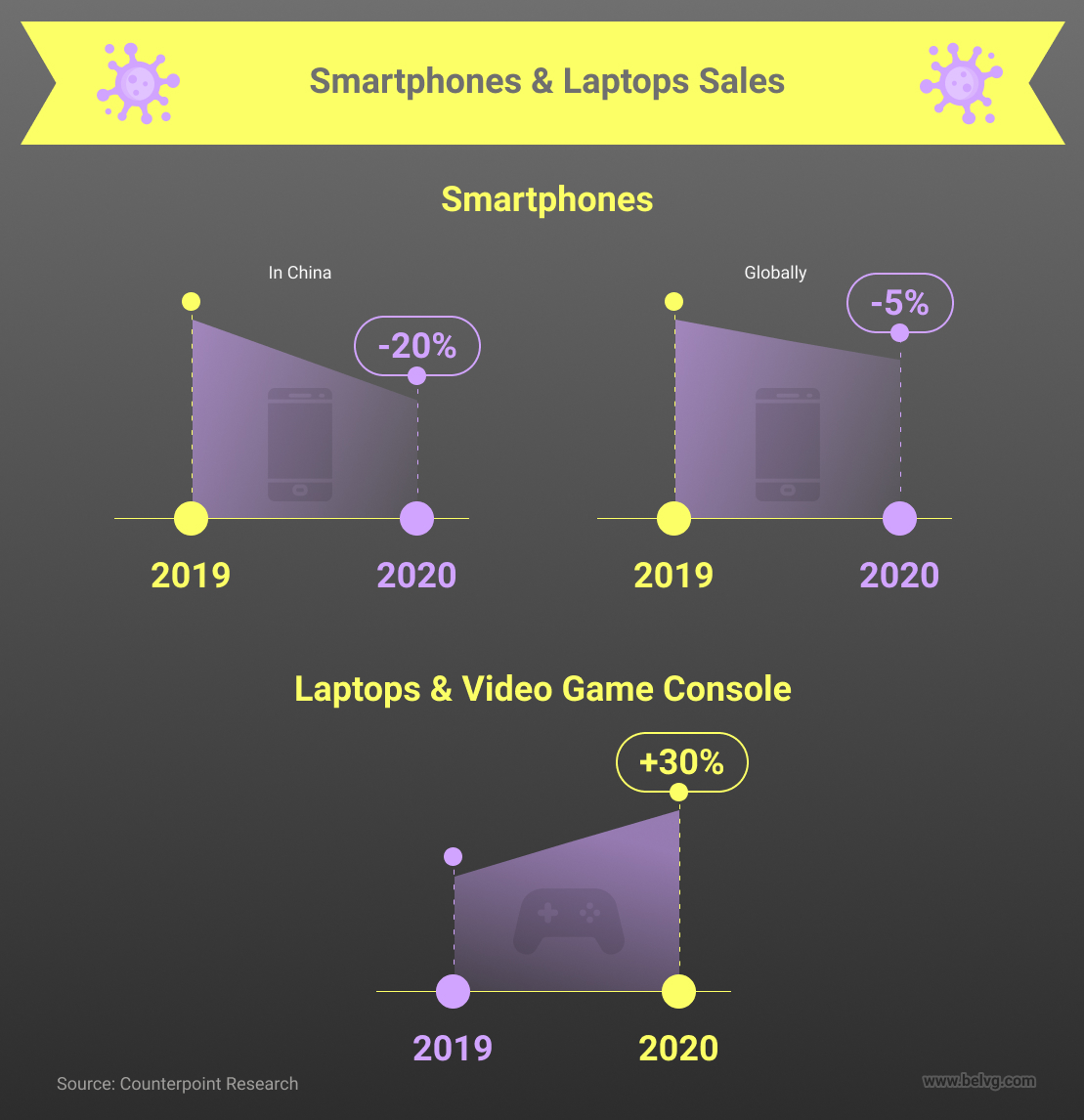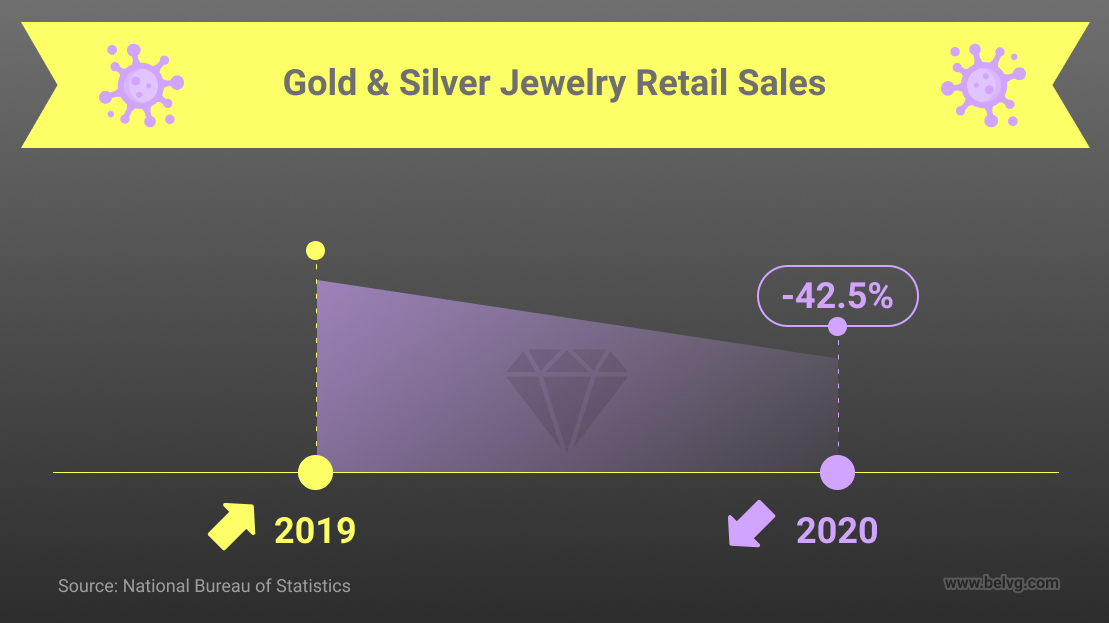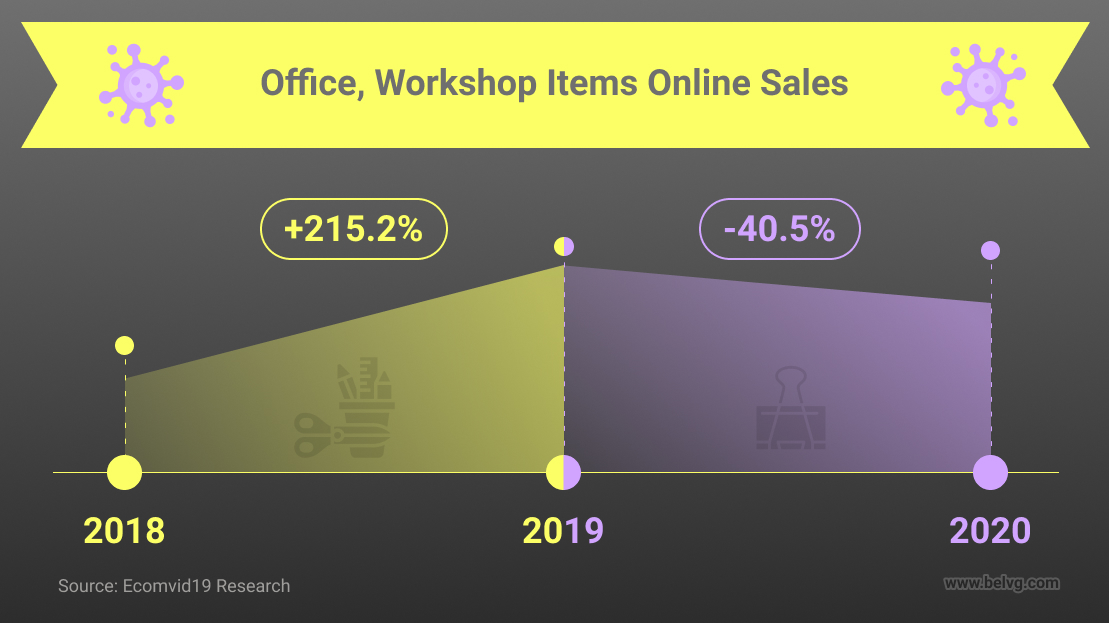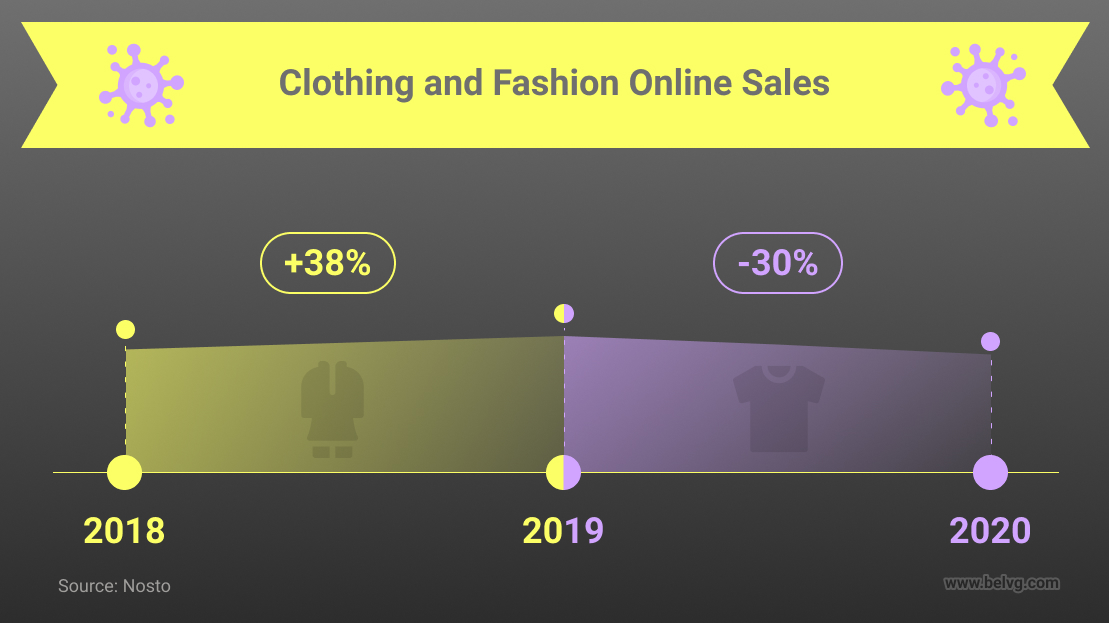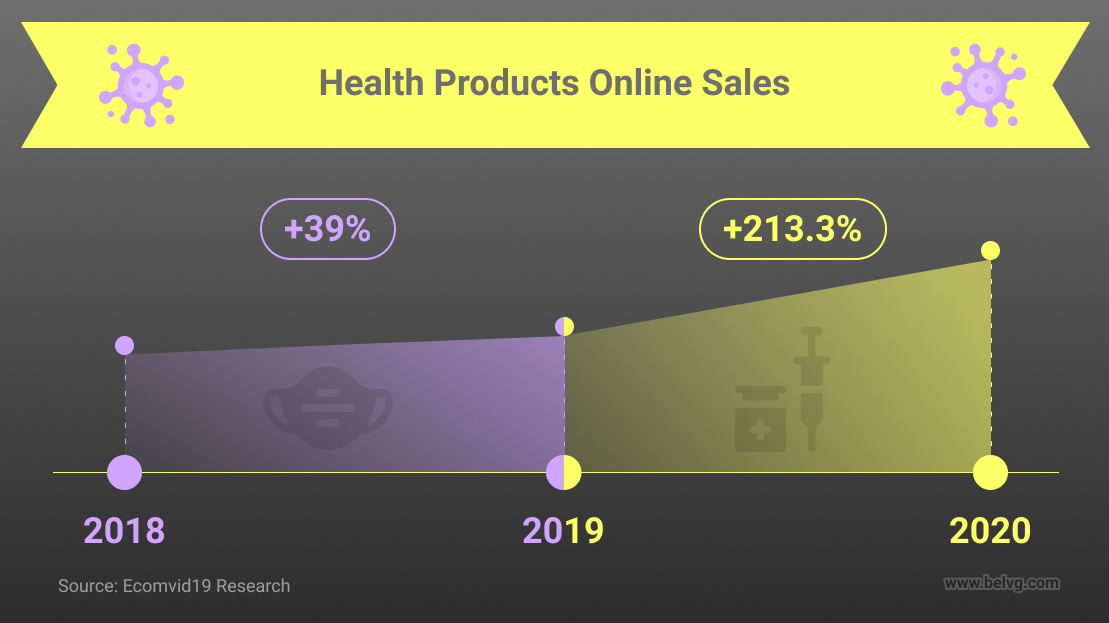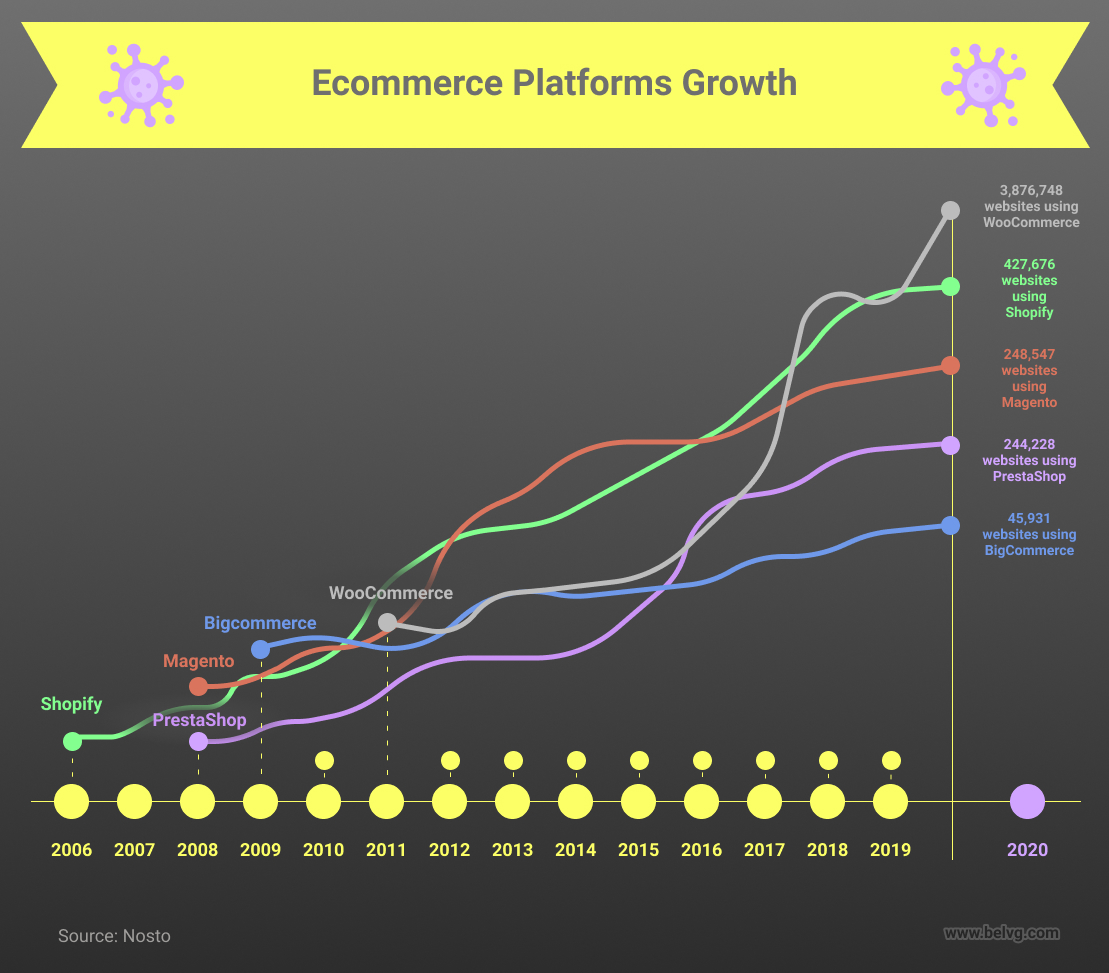
The Covid-19 virus began its way in China near the end of 2019 and in several months developed into a global pandemic. The epidemic situation is frightening, but what are economic losses? How does this situation affect ecommerce? Let’s figure out what is going on.
How Covid-19 Impacts Global Economy
How Covid-19 Affects Ecommerce
Covid-19 Outbreak: Ecommerce Winners vs Losers
What is the Ecommerce Future after Covid-19?
Struggling with Covid-19, most of the countries take a number of measures and follow WHO recommendations to slow down the spread of the virus and protect the people. What do they do:
- Voluntary home isolation for 14 days for people who arrived back from certain countries.
- Movements of citizens between regions and towns are banned, except for urgent cases.
- People are banned from leaving homes. Governments in most countries allow only going to the pharmacy, grocery and walking the dog. In several countries like Germany, Russia, Italy, Spain, there are fines and in some countries people can even go to prison for quarantine violation.
- All the bars, cafes, cinemas, theater, museums, sports facilities, events and educational institutions are closed in most of the countries with the increasing number of COVID-19 cases.
- The borders between countries are kept sealed for tourists. In some cases, they are open only for suppliers to provide people with necessities like medicine and foodstuffs.
These actions sufficiently contribute to preventing the spread of disease. However, they also affect most businesses worldwide – especially small and middle-scale. They bear large losses due to the absence of customers, low sales and need to pay rent even if all the employees work from home.
Thus, Covid-19 is to become a remarkable event in world history due to the epidemic consequences and impact on the global economy. We can often see that it is compared to the global Financial Crisis of 2009 but some experts predict that it is going to hit the economy even harder.
How Covid-19 Impacts Global Economy
According to the World Economic Forum, it can take three years for the US and European economy to recover after the pandemic crisis. And it’s one of the most positive economic forecasts. So, what is the current economic situation?
Covid-19 affects all the industries and markets with no exceptions. The sphere of consumption, which makes up to 65% of the US GDP, feels the highest damage during the crisis. The Covid-19 outbreak forced the government to close shops, restaurants and other businesses where people had to contact face-to-face and could catch the disease. Most of these companies looked for an opportunity to keep offering their products online with delivery and turned their eyes to ecommerce. But closed stores are not the only problem. While people stay home being afraid of pandemic, they just aren’t interested in purchasing most of the items that they would consider buying in a different situation. Another reason for people shopping less even online is decreasing purchasing power – most of the people have less money to spend while staying home and not working.
Covid-19 affects B2B businesses no less than B2C. Most of the companies put on pause making new investments, seeking new partnerships and purchasing new services as they primarily try to handle work-from-home management and also lose a lot of profits.
Global supply chain is blocked and lots of huge multinationals are experiencing difficulties with resources. Some of them, for example Ford, had to shut down production in several countries [1].
As you see, business racks up losses and have to lay off people. For small and middle-scale businesses this situation can turn out fatal and the majority might go bankrupt after the crisis. According to Forbes, not less than 75% of American small companies will go bankrupt if they don’t receive enough financial support from the government in the following 60 days [2].
But while restaurants, barber shops, nail salons and brick-and-mortars are in deadlock, online shopping is thought to be flourishing… or is this not the case?
How Covid-19 Affects Ecommerce
The overall interest in the topic of online shopping in the United States has started growing from the beginning of March right after the pandemic’s global spread. For now, it does not give any signs of going down as multiple states are quarantined.
The similar tendency can be observed in the countries with the highest number of cases in Europe, for example, Italy. Since the beginning of March, people have searched online for online shopping related topics much more often than just a few weeks before.
Google trends demonstrate the same rapidly growing interest in online shopping in the United Kingdom. The interest used to remain stable for quite some time but since March we can observe an unprecedented increase.
You might think that online stores make huge amounts of money at the moment when people try not to leave their houses, avoid brick-and-mortars and order food and all the needed products online. Well, it’s true only about some of the web stores.
The ecommerce is huge and consists of a giant variety of different industries. Here we consider businesses according to the types of products they sell. So, let’s check out what types of products among physical, digital ones and services are in demand during this staying-home crisis.
People spend money primarily on necessities and products that can help them keep themselves and their kids busy during the quarantine, for example, DIY kits, toys or digital products. According to this, even online merchants experience losses – 47% of online retailers expect significant downside in revenue [3]. And 77% of business owners say that it’s possible to sell and deliver products in their city or even country, but they can’t provide people with half of the products due to closed supply-chain and lose clients abroad. So, what online businesses make more money during the Covid-19 outbreak? And which ones go through a challenging time?
Covid-19 Outbreak: Ecommerce Winners vs Losers
Foodstuffs with a long shelf life, toilet paper, sanitizers, all of it is flying off the shelves in both brick-and-mortars and online stores. But what about other products? Let’s look through the different categories – best selling vs worst selling product types during the Covid-19 pandemic.
Food & Grocery Online Retail
At the beginning of the Covid-19 outbreak in the US, there was a massive boom in food and grocery delivery. People wanted to buy as much as they could to avoid visiting crowded supermarkets in the near future. While most of the families, couples and singles are quarantined, online grocery retailers process twice more orders than during the same period of time last year.
There is a high chance that even the most sceptical people will discover the convenience of online grocery shopping during the quarantine. And when the Covid-19 pandemic calms down, it is likely that they will keep using this service. It is definitely good for online grocery retailers, especially, the huge ones like Walmart and Amazon but in the long-term, it can negatively affect local supermarkets and small chains of offline-only shops.
Toys, Hobbies & DIY Ecommerce Sales
People have to spend all their time at home. To survive during the quarantine, the majority of people order online everything necessary to keep themselves busy, including craft kits, hobby stuff, toys, DIY guides and tools. As most of the physical stores selling these products are closed, people primarily rely on ecommerce and delivery. Staying home 24/7 is not easy for most of us and crafting something with a family is a good way to escape negative feelings and a bad mood.
Electronics Retail
Covid-19 has ramped up the demand for statitionary devices like hardware, computers, laptops, monitors, and notebooks by 30%. The reason is clear – most of the companies around the world encourage their employees to work from home. As a result, people need the devices that they would usually use at the office.
Interesting fact: Amazon has reported that during the pandemic bread making machines have become their best-selling electronic device [4]. For now, the most popular models have already been completely sold out.
Personal life during the quarantine goes on smartphones. The daily internet mobile traffic is growing unstoppably which is highly profitable for internet providers. At the same time, during this time of high loads, it is difficult for them to provide their services efficiently. The stats show the following tendency:
- At the beginning of January, on average people spent 6.1 hours a day online with their mobile device.
- At the beginning of February, the number grew up to 6.8 hours a day.
- By the end of February, it has reached 7.3 hours a day on average.
It would be a good sign for smartphone retailers but it turned out that people are less likely to purchase new portable devices now. Some multinational corporations as Apple have already announced that they won’t meet the revenue goals this quarter [5].
The rise in mobile traffic also caused a great increase in social media usage. Due to the increasing number of YouTube visitors, they had to lower the overall video quality to decrease the pressure on its servers. Another stats that should interest social media marketers is that there is a 76% increase in Instagram likes [6]. If you are running a B2C business and selling items that can interest people now, it is a good time to launch an Instagram ad campaign.
Jewelry & Luxury Products
These types of products have never been easy to sell online and during the pandemic the situation is not better but much worse than usually. Staying home does not encourage people to shop more for expensive luxury products. Even those who can afford it on a daily basis prefer to put jewelry and other high-end items purchased on the waiting list until the situation becomes a bit better and they will be able to visit physical stores to buy what they need.
Office, Workshop Items Sales
Both B2B and B2C businesses try to cut back on their spendings by all means. While so many people work from home or are being quarantined, corporate orders of office supplies are in most of the cases suspended. The office workers also do not purchase these items themselves as most of the people who work remotely, use their laptops or desktop computers. Children have extended holidays or take part in distance education and their parents have no need to shop for school supplies yet. As you see, office suppliers and workshops bear large losses due to the pandemic.
Building Materials Online Retail
Interesting fact: while lots of people have to stay home, many of them started rebuilding and redecorating their apartments. The online sales of building materials went up by over 109% compared to the same period of 2019 [7]. It can also be explained by the fact that many people who are banned from leaving homes, do not have an opportunity to work remotely. It means that they have even more free time. As soon as the Covid-19 pandemic started, most of the building material retailers – even those who did not trust in ecommerce before, went online offering special delivery terms like contact-free delivery.
Clothing and Fashion Online Sales
Fashion is one of the categories which is hurt most by the coronavirus impact on the economy and people’s shopping behavior. Compared to the last year, the sales went down by 30%. Clothing items are named in all the lists of the fastest declining product categories, for example:
- The sales of men’s swimwear went down by 64% and women’s by 59%.
- Wedding clothes sales declined by 63%.
- Athletic shoes sales decreased by 59%.
Visual capitalist reports that, the time of the Covid-19 pandemic has become the worst period for the fashion retailers since the global Financial Crisis of 2009 [8].
Health Products Sales
As you’ve probably expected, the demand for health products is still going up. During the pandemic, we can also observe a growing interest among customers in vitamins, minerals and herbs. It can be explained by people trying to support their immune system by all means. Another category of such products which is popular now is antiviral, cough, flu and cold medicines. The greatest boom in sales took place at the beginning of March but now regular demand is still high and stable.
Chemist’s Sales
The retailers of chemist’s enjoy a 124% increase in sales this year compared to the previous one. We can see a fast-growing demand for hand sanitisers and other hygiene products. Following the WHO recommendations, people disinfect their hands and items of frequent use at least a couple of times a day, it causes the extremely high demand which the suppliers are often not able to meet. It means that you can hardly find sanitisers available at the local drugstore. Most of the governments also announced a recommendation for all the entities which are still open to provide hand sanitisers which increases the demand for large quantity supplies.
What is the Ecommerce Future after Covid-19?
If we look back at the times of the global financial crisis of 2008 and its impact on the economy, we can fully agree with the saying that the times of crisis have always been the times of opportunities.
Before 2009, ecommerce sales had never made more than 5.5% of total retail sales and the average year-over-year growth always remained about 0.2-0.3%. Soon after the global crisis was over – already in 2010, the ecommerce sales share reached 6.4%, then 7.2% in 2011. Average year-over-year growth increased up to 0.8-0.9% and reached 1.6% by 2019 [9].
Basically, ecommerce itself started to ramp up after the crisis. At the same, this sales increase and interest in online shopping resulted in the rise of the new ecommerce platforms. Magento and PrestaShop were launched in 2008, Bigcommerce in 2009. Even though Shopify was there before – in 2006 – it did not reach popularity until the ecommerce boom by the end of the GFC.
WooCommerce joined the race in 2011 and became highly popular almost immediately due to the WordPress prominence. The number of blogs and corporate websites on WordPress was already impressive, and many of them wanted to give this plugin a try and take part in the promising ecommerce retail.
At the same time, the 2009 flu pandemic in Asia caused an increasing number of internet users across China, India, Thailand, South Korea and others. Because of the quarantine regime people did not have another option but to give online shopping a try. The same situation as we observe today in most of the countries has built a solid ground for the future development of ecommerce in East and South Asia.
Today, Asian digital market is still the most rapidly growing one. In Indonesia only, the ecommerce sales make up to $21 billion and it is predicted that at the current pace, online retail sales will reach $82 billion by 2025 [10]. The Middle-class in Asia is growing together with the number of internet users who are encouraged to shop online by the pandemic and quarantine.
When it comes to the ecommerce future after the Covid-19 outbreak, we can expect the increasing number of sales and digital shoppers, beginning with the Asian market. At the same time, the growing number of users will cause more competition and new technologies development.
Conclusion
Hopefully, this article has helped you to develop an understanding of ecommerce industry shifts and changes during the Covid-19 outbreak. Let’s briefly wrap it up:
- The current economic situation forces many online stores to invest twice more money in advertising and provide different discounts to encourage people to buy. However, this strategy does not prove itself to be really effective.
- Some manufacturers while bearing losses try to work for the common good, for example, fashion stores start producing masks for hospitals.
- Luxury products, office supplies, smartphones, fashion items are not in demand during the pandemic and the long-lasting quarantine will damage many businesses operating in these fields even worse.
- Food, grocery, toys, DIY kits, laptops, notebooks, hardware, health products and chemist’s are selling in large quantities, the sales are only growing and for some of these product categories it has already become difficult to meet the demand.
Thank you for reading our article and stay tuned for more Covid-19 ecommerce updates with our blog. In the coming article, we are going to share the best tools to improve your online business and market knowledge that have become free during the pandemic.
We wish all of you good health! Stay Home & Stay Safe.

